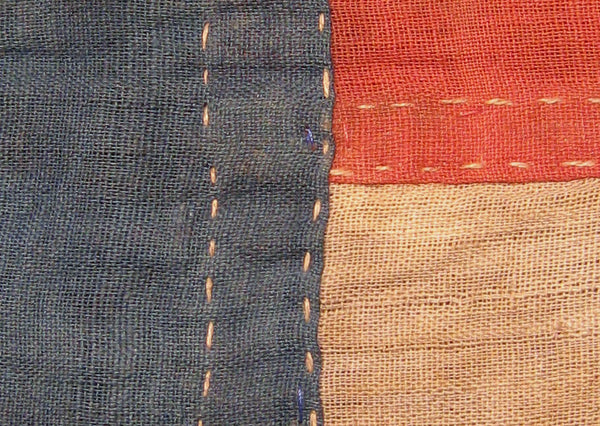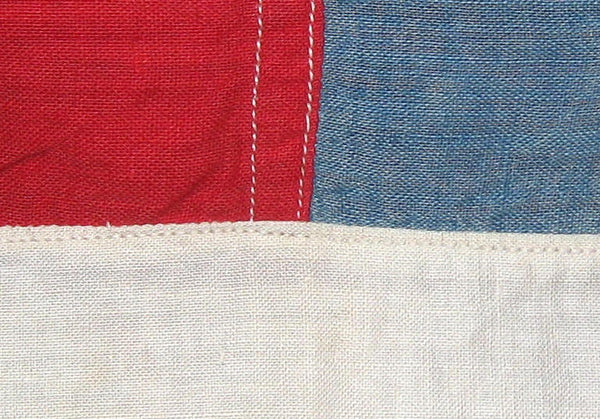Flag fabric - a long history
Wool
Wool is an animal fibre produced from spinning the hair of sheep. As a protein-based fire, wool that is burned exudes the smell of burning hair. Wool flags generally feel coarse, and the weave of wool fabric is generally looser than cotton or linen, and certainly looser than silk. Wool is chosen for flags because of its excellent ability to withstand water. Since it is a product of natural animal hair, it doesn't rot as readily as vegetable fibres like cotton or linen. Wool over 200 years old can still be vibrant and supple. Moths do tend to feed on wool, and many holes in wool flags are due to mothing, especially with flags that are stored for years in attics, barns, garages, and basements.
When examined very closely, the earliest wool flags, which date to the 18th and early 19th Century, were made of wool bunting that is very loosely and irregularly woven. This pre-industrial era wool is distinct and a good indicator of whether or not a flag with a low star count is in fact a possible authentic period example rather than a later-period flag. Shown here are close up images of wool bunting from flags of various eras, from the early 19th Century through the 20th Century. Note how in the earliest flag, the weave is very irregular, whereas in the wool bunting produced by machine in the mid- to late 19th Century, and into the 20th Century, the weave becomes very consistent and regular.




Cotton
Cotton is a vegetable fiber produced from the boll that grows around the seeds within the seed pod of cotton plants. The fiber is spun into cotton yarn or cotton thread, and woven to produce cotton cloth. There are very early examples of cotton American flags, including those that predate the Civil War. Cotton was widely available as a household fabric, and was especially more prevalent for home use than animal materials such as wool bunting or silk. For many homemade American flags, cotton was the fabric of choice. When wet, cotton is heavier than wool and tends to become brittle and deteriorate. Cotton stored in hot or moist climates can also experience dry rotting. On most wool flags, cotton is typically the fabric of choice for sewn stars, owing to cotton's brighter coloration and tighter weave.

Cotton, circa 1845. The cotton fabric in this hand-sewn 27 star flag, circa 1845, shows a loose irregular weave. In the images of the whole flag, one can see the striations caused by variations in the density of the weave and irregularities in the vegetable dyes used to color the fabric.

Cotton, circa 1861. This cotton fabric is of a fine quality for the period, and is well dyed. This hand sewn flag remains in an extraordinary state of preservation despite evidence, such as the water marks visible in the image, of being used outdoors.

Cotton, circa 1876. Cotton from the Centennial era in this 38 star flag, homemade in Lebanon, Indiana for the 4th of July, 1876, shows vibrant red, bright white and cornflower blue coloration. Note the extremely fine machine stitching, which measures at 19 to 20 stitches per inch.
Linen
Linen is a vegetable fibre made from the fibre of the flax plant. Linen textiles are some of the oldest in the world. Homespun linen is a staple fabric. Though much less common than cotton today, linen fabric produced in early America was valued for its durability (linen is 2 to 3 times stronger than cotton) and, as an excellent conductor of heat, its coolness in warm weather. (For more information see Linen, Wikipedia.)
One of the best case studies for the use of linen in an early American flag is the 19 Star flag in this collection, as described below. The original 19 stars of the flag are made of identical homespun linen as the stripes of the flag. The two sets of added stars, which brought the total number of stars to 25, are clearly sewn by a different hand, but more importantly, are of a less tight, lower quality linen weave. This is solid evidence that when originally produced, the flag consisted of 19 stars, which were later updated. Note also how the linen, unlike cotton, has an almost pearl-like appearance under magnification.
Close up of an original star and its adjacent white stripe. Note the identical weave of the linen fabric. Also note the loose, irregular wool bunting, consistent with early 19th century wool fabric.
Silk
Silk is a natural protein fibre obtained most commonly from the cocoon of the larvae of the mulberry silkworm. One of the most luxurious and expensive of all fabrics, the use of silk in American flags is typically reserved for the finest quality flags, most often for military or official use. Several qualities of silk make it an exceptionally good fabric for use in flags. The material is light-weight, exceptionally strong, tightly woven and weathers well. Its shimmering appearance is beautiful and impressive. For military standards, silk allows for large flags that are light and which dry quickly. The fineness of the material allows for the application of painted decorations, as is often seen in the painted stars and decorative cantons of flags produced for wartime use, especially those of the American Civil War.
One unfortunate problem with antique silk flags is that large numbers of them, including many Civil War era battle standards, were made of "weighted silk". Sold for centuries by length, merchants shifted from selling silk by length to selling it by weight, beginning in the early 19th century (circa 1820-1830). In order to earn more money for their silk, merchants frequently soaked the silk in water laden with mineral salts. Once dried, the mineral salts remained in the silk fibres and added weight to the silk, thus bringing the merchant more money. Unfortunately, these mineral salts proved to be caustic and caused severe breakdown in the silk fibres over time. Many flags made of weighted silk are very brittle, often deteriorating under their own weight. Yet flags made of unweighted silk, some of which are decades older than later weighted silk flags, remain in a remarkable state of preservation.
Source: http://www.rareflags.com/rareflags_collecting_fabrics.htm


